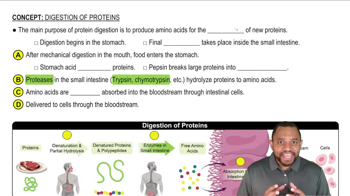Here are the essential concepts you must grasp in order to answer the question correctly.
Protein Digestion
Protein digestion involves breaking down proteins into smaller peptides and amino acids through the action of enzymes like pepsin in the stomach and trypsin in the small intestine. This process is essential for the body to utilize amino acids for various functions, including tissue repair and enzyme production.
Recommended video:
Digestion of Proteins Concept 1
Lipid Digestion
Triacylglycerols, or triglycerides, are digested primarily in the small intestine by enzymes called lipases, which break them down into glycerol and free fatty acids. This process is crucial for energy production and the absorption of fat-soluble vitamins.
Recommended video:
Digestion of Lipids Example 1
Carbohydrate Digestion
Carbohydrates like maltose, sucrose, lactose, and starch are digested into simple sugars (monosaccharides) through enzymatic action. Enzymes such as amylase and maltase play key roles in this process, allowing the body to convert carbohydrates into glucose for energy.
Recommended video:
Digestion of Lipids Example 1



